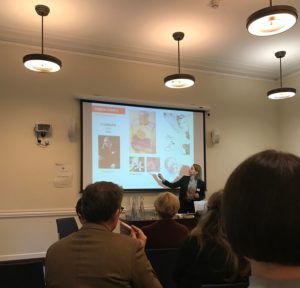Sasha Rasmussen discusses the recent conference ‘Common Scents’ held in November 2018 at the IMLR:
In late November, the Institute for Modern Languages Research hosted ‘Common Scents’, a two-day conference with an interest in all things olfactory, framed by the literature of the late nineteenth and early twentieth centuries. Across the varied and thought-provoking papers, the speakers engaged with scent through a range of lenses, including disgust, dissimulation, exoticism, pleasure, sexuality, and consumerism.
 Perhaps the most fundamental theme of the conference was the epistemological role of smell, and the kinds of knowledge it can provide. The opening keynote paper by philosopher Barry Smith laid the foundations for many of the ensuing discussions, by setting out the basics and recent discoveries of the neuro-physiological science of smell. He stressed the strong and immediate link between the sense of smell and the emotions, a topic we were to return to repeatedly over the course of the conference. Erika Wicky tackled this question directly in her paper ‘The Dandy’s Nose: Aesthetics and Olfactory Sensitivity in French Literature of the fin de siècle’, teasing out the importance of smell in art connoisseurship. She argued that as the viewer approaches the canvas, they move from the visual to the olfactory, and from the objective to the emotional or experiential.
Perhaps the most fundamental theme of the conference was the epistemological role of smell, and the kinds of knowledge it can provide. The opening keynote paper by philosopher Barry Smith laid the foundations for many of the ensuing discussions, by setting out the basics and recent discoveries of the neuro-physiological science of smell. He stressed the strong and immediate link between the sense of smell and the emotions, a topic we were to return to repeatedly over the course of the conference. Erika Wicky tackled this question directly in her paper ‘The Dandy’s Nose: Aesthetics and Olfactory Sensitivity in French Literature of the fin de siècle’, teasing out the importance of smell in art connoisseurship. She argued that as the viewer approaches the canvas, they move from the visual to the olfactory, and from the objective to the emotional or experiential.
Scent also served as an important marker in other contexts: bad odours were variously identified as a sign of the lower classes, of poor moral conduct, and sexual decadence or degeneracy. This is testament to the understanding of smell as ‘the truest sense’. However, as we heard, the nose can also be fooled: sweet perfumes were thought to mask reality, allowing women to present themselves not as they are, but as they wish to be read by passing strangers.
Scent has, as Catherine Maxwell put it, ‘an unrivalled ability of evoking past states of feeling’. But this ability was also commodified and subverted. As Jonathan Day argued (in absentia), there came a point when the answer to Molly Bloom’s question, ‘what perfume does your wife wear?’, was answered with a brand name, not a material substance like violet or lily of the valley. The narratives carried by various scents, too, were commercialised, as Tag Groenberg outlined in her paper on the marketing of abstract perfumes, ‘Shalimar and Vol de Nuit (Guerlain): Scents of Presence and Loss’. Expectations regarding gender were a powerful force in shaping such narratives, as Maria Weilandt and Sophie-Valentine Borloz both demonstrated in their analyses of French literary examples from the fin-de-siècle.
Many presentations across the two days dealt indirectly with the difficulties of conveying the so-called lower senses – and smell in particular – to a reading audience through language alone. Perhaps to partially counteract such difficulties, several sessions featured olfactory props: Catherine Maxwell passed around samples of damask rose, narcissus, and a sprig of myrtle during her keynote on scent in the works of Vernon Lee. Isabelle Chazot of the Osmothèque in Paris brought with her a recreation of a 1905 perfume by Koty from the organisation’s curated collection of perfumes, past and present, allowing attendees to catch a whiff of the belle époque. Experiencing the scent ourselves added a new dimension to the conference, although for me as a historian this raised questions about the contingent nature of sensory experience and the immeasurable distance between our own interpretive framework and that of the past.
counteract such difficulties, several sessions featured olfactory props: Catherine Maxwell passed around samples of damask rose, narcissus, and a sprig of myrtle during her keynote on scent in the works of Vernon Lee. Isabelle Chazot of the Osmothèque in Paris brought with her a recreation of a 1905 perfume by Koty from the organisation’s curated collection of perfumes, past and present, allowing attendees to catch a whiff of the belle époque. Experiencing the scent ourselves added a new dimension to the conference, although for me as a historian this raised questions about the contingent nature of sensory experience and the immeasurable distance between our own interpretive framework and that of the past.
The conference also took a strong interest in the ‘synaesthetic moment in modernist literature’, and particularly the relationship between smell and sound. Zola offers a number of evocative examples, from the ‘cheese symphony’ of Le Ventre de Paris to Albine in La Faute de l’Abbé Mouret, who as she died ‘listened to the perfumes’ of the flowers which filled her bedroom. In complement to these French examples, Frank Krause gave a detailed consideration of this phenomenon from a Germanic perspective in his paper ‘Innovative Smell-Sound Synaesthesiae: Diagnoses of Social Life in German Literature’. The ways in which the senses might be unexpectedly juxtaposed, so that smell might comment on sound and vice versa, holds exciting potential for future research.
Overall, the conference represented a fascinating cross-section of current scholarship concerned with scent and its representations. An enormous thank you and congratulations are owed to the organisers of the conference – Katharina Herold, Frank Krause, and Godela Weiss-Sussex – for their efforts in bringing together such a stimulating event.
Sasha Rasmussen, PhD student, (St Hilda’s College, Oxford)
.
